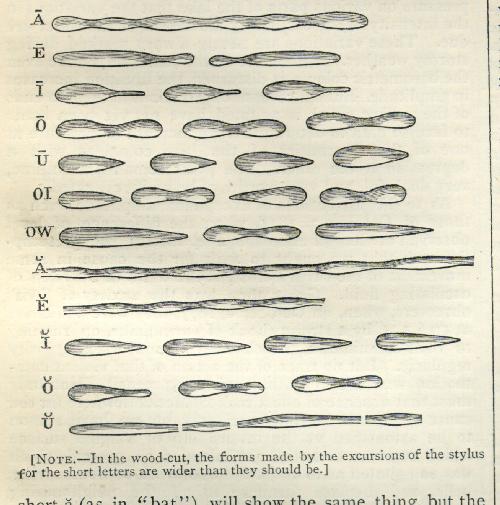
Phonozoic Text Archive, Document 107
Examination of the Phonograph Record Under the Microscope
Nature, Vol XVIII, May 23, 1878, p. 101-02.
Note: Long and short vowels are indicated here
as Í and Ì, respectively, since html does not support the proper characters.
Abstract of paper
presented at the Franklin Institute April 17, 1878, by Persifor Frazer, Jun.,
A.M.
MR. FRAZER referred to previous results obtained by him of some examinations of the tin foil which had been indented by the stylus, or needle point, of the pho- [102] nograph. His object was to ascertain the shapes of the indentations made by different known sounds. The vowels and diphthongs were spoken into the mouthpiece of the apparatus with small panels in the order seen on the diagram.
These sounds were repeated thrice on each of three foils. They were then mounted on glass plates, separated, and labelled. Finally, they were cut out and mounted on another piece of glass vertically, instead of horizontally, in order that a number of the dents produced by any given sound might be on the screen at once.
Lissajous, Leon Scott, and König have provided the means of transforming sounds into form, in various ways, viz., by bright points on the ends of steel bars of different thicknesses; by vibrating membranes at the extremity of a “phonautograph,” and by flames reflected in a rotating mirror. It was natural to conclude that the same vibrations, imparted to a steel point by means of a metal diaphragm, would leave an equally characteristic trace.
The same voice (that of Dr. Plush), speaking the following vowels and diphthongs as nearly as possible at the same distance from the mouthpiece, was relied upon for the matrices.
The first records tried, to ascertain whether the pronunciation was perfect, were afterwards thrown away, and the records which were studied were not in any way injured by a second passage of the point of the stylus.
By following along the nearly vertical line of impressions, which are at the same time in focus, it will be observed that this line consists of one long followed by two shorts (or two shorts followed by one long), the indentations bearing a general resemblance to each other and to seeds. This is long A, or “Ah.” A glance at short à (as in “bat”), will show the same thing, but the seed-shaped hollows are narrower, and there are no abrupt terminations of the hollows by intervening parts of the foil, which have not been touched by the needle-point.
É (or ay), on the screen, looked like the magnets of two Bell telephones, with the small ends turned towards each other. In the diagram they look like two Indian clubs with the handles together. The same general resemblance is observed in E short, except that, as in à short, the volume of sound being less, the intensity was less, or (what is the measure of intensity) the path of the needle-point was shorter, and it seldom entirely cleared the foil, the consequence being a continuous groove of irregular, but normally irregular, width.
Í and Ì are much alike in general form, as also are Ó and Ò, the coupling of the pairs of the latter being the most striking feature. Ú and Ù, in the drawing, best show the difference in shape produced by less intensities, the short being drawn out, and more acicular.
OI is very interesting. The diphthong consists of ÒÌ, and the very moulds which characterise their sounds are to be observed in the cut.
OW presents a composite character, but its derivation has not yet been made out.
The above presentation of the subject is necessarily crude and imperfect, but will illustrate the possibilities of an exhaustive investigation.
